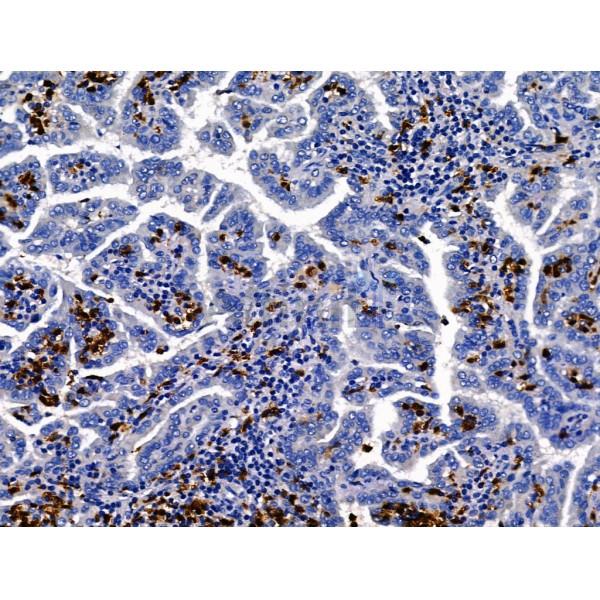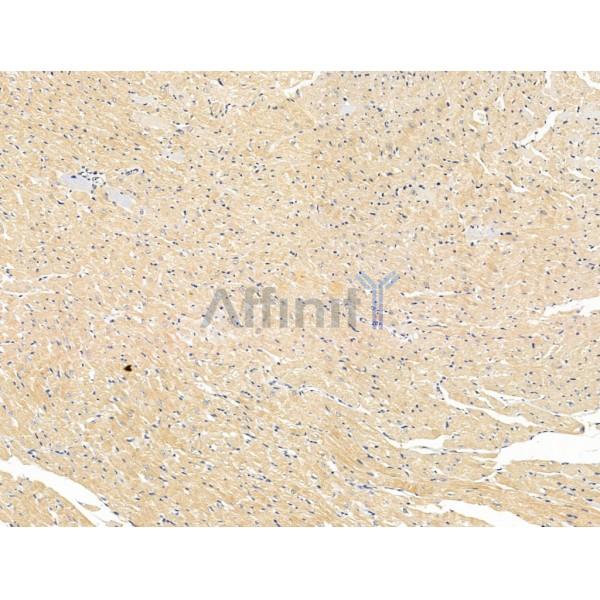LOXL2 Antibody - #DF13442
| Product: | LOXL2 Antibody |
| Catalog: | DF13442 |
| Description: | Rabbit polyclonal antibody to LOXL2 |
| Application: | WB IHC IF/ICC |
| Cited expt.: | IHC |
| Reactivity: | Human, Mouse, Rat |
| Prediction: | Pig, Bovine, Horse, Sheep, Rabbit, Dog, Chicken, Xenopus |
| Mol.Wt.: | 86kDa; 87kD(Calculated). |
| Uniprot: | Q9Y4K0 |
| RRID: | AB_2846461 |
Related Downloads
Protocols
Product Info
*The optimal dilutions should be determined by the end user. For optimal experimental results, antibody reuse is not recommended.
*Tips:
WB: For western blot detection of denatured protein samples. IHC: For immunohistochemical detection of paraffin sections (IHC-p) or frozen sections (IHC-f) of tissue samples. IF/ICC: For immunofluorescence detection of cell samples. ELISA(peptide): For ELISA detection of antigenic peptide.
Cite Format: Affinity Biosciences Cat# DF13442, RRID:AB_2846461.
Fold/Unfold
LOR 2; LOR2; LOX L2; LOXL 2; LOXL2; LOXL2_HUMAN; Lysyl oxidase homolog 2; Lysyl oxidase like 2; Lysyl oxidase like protein 2; Lysyl oxidase related 2; Lysyl oxidase related protein 2; Lysyl oxidase related protein WS9 14; Lysyl oxidase-like protein 2; Lysyl oxidase-related protein 2; Lysyl oxidase-related protein WS9-14; WS9 14;
Immunogens
A synthesized peptide derived from human LOXL2, corresponding to a region within the internal amino acids.
Expressed in many tissues (PubMed:10212285). Highest expression in reproductive tissues, placenta, uterus and prostate (PubMed:10212285). In esophageal epithelium, expressed in the basal, prickle and granular cell layers (PubMed:22204712). Up-regulated in a number of cancers cells and tissues.
- Q9Y4K0 LOXL2_HUMAN:
- Protein BLAST With
- NCBI/
- ExPASy/
- Uniprot
MERPLCSHLCSCLAMLALLSPLSLAQYDSWPHYPEYFQQPAPEYHQPQAPANVAKIQLRLAGQKRKHSEGRVEVYYDGQWGTVCDDDFSIHAAHVVCRELGYVEAKSWTASSSYGKGEGPIWLDNLHCTGNEATLAACTSNGWGVTDCKHTEDVGVVCSDKRIPGFKFDNSLINQIENLNIQVEDIRIRAILSTYRKRTPVMEGYVEVKEGKTWKQICDKHWTAKNSRVVCGMFGFPGERTYNTKVYKMFASRRKQRYWPFSMDCTGTEAHISSCKLGPQVSLDPMKNVTCENGLPAVVSCVPGQVFSPDGPSRFRKAYKPEQPLVRLRGGAYIGEGRVEVLKNGEWGTVCDDKWDLVSASVVCRELGFGSAKEAVTGSRLGQGIGPIHLNEIQCTGNEKSIIDCKFNAESQGCNHEEDAGVRCNTPAMGLQKKLRLNGGRNPYEGRVEVLVERNGSLVWGMVCGQNWGIVEAMVVCRQLGLGFASNAFQETWYWHGDVNSNKVVMSGVKCSGTELSLAHCRHDGEDVACPQGGVQYGAGVACSETAPDLVLNAEMVQQTTYLEDRPMFMLQCAMEENCLSASAAQTDPTTGYRRLLRFSSQIHNNGQSDFRPKNGRHAWIWHDCHRHYHSMEVFTHYDLLNLNGTKVAEGHKASFCLEDTECEGDIQKNYECANFGDQGITMGCWDMYRHDIDCQWVDITDVPPGDYLFQVVINPNFEVAESDYSNNIMKCRSRYDGHRIWMYNCHIGGSFSEETEKKFEHFSGLLNNQLSPQ
Predictions
Score>80(red) has high confidence and is suggested to be used for WB detection. *The prediction model is mainly based on the alignment of immunogen sequences, the results are for reference only, not as the basis of quality assurance.
High(score>80) Medium(80>score>50) Low(score<50) No confidence
Research Backgrounds
Mediates the post-translational oxidative deamination of lysine residues on target proteins leading to the formation of deaminated lysine (allysine). Acts as a transcription corepressor and specifically mediates deamination of trimethylated 'Lys-4' of histone H3 (H3K4me3), a specific tag for epigenetic transcriptional activation. Shows no activity against histone H3 when it is trimethylated on 'Lys-9' (H3K9me3) or 'Lys-27' (H3K27me3) or when 'Lys-4' is monomethylated (H3K4me1) or dimethylated (H3K4me2). Also mediates deamination of methylated TAF10, a member of the transcription factor IID (TFIID) complex, which induces release of TAF10 from promoters, leading to inhibition of TFIID-dependent transcription. LOXL2-mediated deamination of TAF10 results in transcriptional repression of genes required for embryonic stem cell pluripotency including POU5F1/OCT4, NANOG, KLF4 and SOX2 (By similarity). Involved in epithelial to mesenchymal transition (EMT) via interaction with SNAI1 and participates in repression of E-cadherin CDH1, probably by mediating deamination of histone H3. During EMT, involved with SNAI1 in negatively regulating pericentromeric heterochromatin transcription. SNAI1 recruits LOXL2 to pericentromeric regions to oxidize histone H3 and repress transcription which leads to release of heterochromatin component CBX5/HP1A, enabling chromatin reorganization and acquisition of mesenchymal traits. Interacts with the endoplasmic reticulum protein HSPA5 which activates the IRE1-XBP1 pathway of the unfolded protein response, leading to expression of several transcription factors involved in EMT and subsequent EMT induction. Involved in E-cadherin repression following hypoxia, a hallmark of EMT believed to amplify tumor aggressiveness, suggesting that it may play a role in tumor progression. When secreted into the extracellular matrix, promotes cross-linking of extracellular matrix proteins by mediating oxidative deamination of peptidyl lysine residues in precursors to fibrous collagen and elastin. Acts as a regulator of sprouting angiogenesis, probably via collagen IV scaffolding. Acts as a regulator of chondrocyte differentiation, probably by regulating expression of factors that control chondrocyte differentiation (By similarity).
The lysine tyrosylquinone cross-link (LTQ) is generated by condensation of the epsilon-amino group of a lysine with a topaquinone produced by oxidation of tyrosine.
N-glycosylated. N-glycosylation on Asn-455 and Asn-644 may be essential for proper folding and secretion; may be composed of a fucosylated carbohydrates attached to a trimannose N-linked glycan core.
Secreted>Extracellular space>Extracellular matrix>Basement membrane. Nucleus. Chromosome. Endoplasmic reticulum.
Note: Associated with chromatin (PubMed:27735137). It is unclear how LOXL2 is nuclear as it contains a signal sequence and has been shown to be secreted (PubMed:23319596). However, a number of reports confirm its intracellular location and its key role in transcription regulation (PubMed:22204712, PubMed:22483618).
Expressed in many tissues. Highest expression in reproductive tissues, placenta, uterus and prostate. In esophageal epithelium, expressed in the basal, prickle and granular cell layers. Up-regulated in a number of cancers cells and tissues.
The fourth SRCR domain plays an important role in optimizing the catalytic activity of the lysyl-oxidase like (LOX) catalytic domain.
Belongs to the lysyl oxidase family.
References
Application: IHC Species: human Sample:
Restrictive clause
Affinity Biosciences tests all products strictly. Citations are provided as a resource for additional applications that have not been validated by Affinity Biosciences. Please choose the appropriate format for each application and consult Materials and Methods sections for additional details about the use of any product in these publications.
For Research Use Only.
Not for use in diagnostic or therapeutic procedures. Not for resale. Not for distribution without written consent. Affinity Biosciences will not be held responsible for patent infringement or other violations that may occur with the use of our products. Affinity Biosciences, Affinity Biosciences Logo and all other trademarks are the property of Affinity Biosciences LTD.




